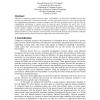Free Online Productivity Tools
i2Speak
i2Symbol
i2OCR
iTex2Img
iWeb2Print
iWeb2Shot
i2Type
iPdf2Split
iPdf2Merge
i2Bopomofo
i2Arabic
i2Style
i2Image
i2PDF
iLatex2Rtf
Sci2ools
SIGOPSE
2000
ACM
2000
ACM
Gaia: enabling active spaces
Ubiquitous computing promotes physical spaces with hundreds of specialized embedded devices that increase our productivity, alleviate some specific everyday tasks and provide new ways of interacting with the computational environment. Personal computers lose the focus of attention due to the fact that the computational environment is spread across the physical space. Therefore, the users’ view of the computational environment is finally extended beyond the physical limits of the computer. Physical spaces become computer systems, or in other terms, Active Spaces. However, these Active Spaces require novel system software capable of seamlessly coordinating their hidden complexity. Our goal is to extend the model provided by current computer systems to allow interaction with physical spaces and their contained (physical and virtual) by means of a single abstraction called Active Space.
| Added | 01 Aug 2010 |
| Updated | 01 Aug 2010 |
| Type | Conference |
| Year | 2000 |
| Where | SIGOPSE |
| Authors | Manuel Román, Roy H. Campbell |
Comments (0)

